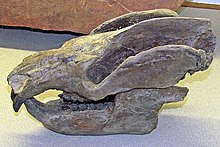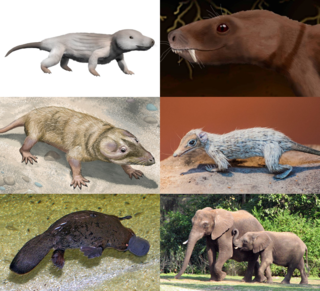
Cynodontia is a clade of eutheriodont therapsids that first appeared in the Late Permian, and extensively diversified after the Permian–Triassic extinction event. Mammals are cynodonts, as are their extinct ancestors and close relatives (Mammaliaformes), having evolved from advanced probainognathian cynodonts during the Late Triassic.
Oligokyphus is an extinct genus of herbivorous tritylodontid cynodont known from the Late Triassic to Early Jurassic of Europe, Asia and North America.

Tritylodon is an extinct genus of tritylodonts, one of the most advanced group of cynodont therapsids. They lived in the Early Jurassic and possibly Late Triassic periods along with dinosaurs. They also shared many characteristics with mammals, and were once considered mammals because of overall skeleton construction. That was changed due to them retaining the vestigial amniote jawbones and a different skull structure. Tritylodons are now regarded as non-mammalian synapsids.
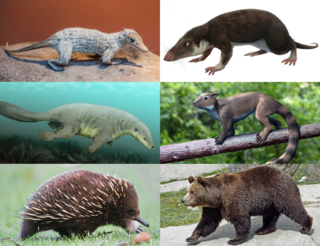
Mammaliaformes is a clade that contains the crown group mammals and their closest extinct relatives; the group radiated from earlier probainognathian cynodonts. It is defined as the clade originating from the most recent common ancestor of Morganucodonta and the crown group mammals; the latter is the clade originating with the most recent common ancestor of extant Monotremata, Marsupialia, and Placentalia. Besides Morganucodonta and the crown group mammals, Mammaliaformes includes Docodonta and Hadrocodium as well as the Triassic Tikitherium, the earliest known member of the group.

The Kayenta Formation is a geological formation in the Glen Canyon Group that is spread across the Colorado Plateau province of the United States, including northern Arizona, northwest Colorado, Nevada, and Utah. Traditionally has been suggested as Sinemurian-Pliensbachian, but more recent dating of detrital zircons has yielded a depositional age of 183.7 ± 2.7 Ma, thus a Pliensbachian-Toarcian age is more likely. A previous depth work recovered a solid "Carixian" age from measurements done in the Tenney Canyon. More recent works have provided varied datations for the layers, with samples from Colorado and Arizona suggesting 197.0±1.5-195.2±5.5 Ma, while the topmost section is likely Toarcian or close in age, maybe even recovering terrestrial deposits coeval with the Toarcian Oceanic Anoxic Event. This last age asignation also correlated the Toarcian Vulcanism on the west Cordilleran Magmatic Arc, as the number of grains from this event correlate with the silt content in the sandstones of the upper layers.
Tritylodontidae is an extinct family of small to medium-sized, highly specialized mammal-like cynodonts, with several mammalian traits including erect limbs, endothermy and details of the skeleton. They were the last-known family of the non-mammaliaform synapsids, persisting into the Early Cretaceous.
Rhamphinion is a genus of pterosaurs from the Sinemurian-mid Pliensbachian-age Lower Jurassic Kayenta Formation of northeastern Arizona, United States. The type species is R. jenkinsi.
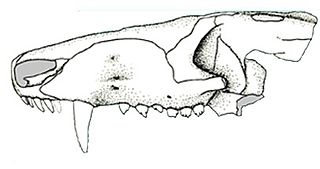
Prozostrodon is an extinct genus of probainognathian cynodonts that was closely related to mammals. The remains were found in Brazil and are dated to the Carnian age of the Late Triassic. The holotype has an estimated skull length of 6.7 centimetres (2.6 in), indicating that the whole animal may have been the size of a cat. The teeth were typical of advanced cynodonts, and the animal was probably a carnivore hunting reptiles and other small prey.
Calsoyasuchus is a genus of crocodylomorph that lived in the Early Jurassic. Its fossilized remains were found in the Sinemurian-Pliensbachian-age Kayenta Formation on Navajo Nation land in Coconino County, Arizona, United States. Formally described as C. valliceps, it is known from a single incomplete skull which is unusually derived for such an early crocodile relative. This genus was described in 2002 by Ronald Tykoski and colleagues; the specific name means "valley head" and refers to a deep groove along the midline of the nasal bones and frontal bones. It has often been interpreted as the earliest diverging member of Goniopholididae, but other studies have recovered it in various other positions.

Progalesaurus is an extinct genus of galesaurid cynodont from the early Triassic. Progalesaurus is known from a single fossil of the species Progalesaurus lootsbergensis, found in the Lystrosaurus Assemblage Zone of the Balfour Formation. Close relatives of Progalesaurus, other galesaurids, include Galesaurus and Cynosaurus. Galesaurids appeared just before the Permian-Triassic extinction event, and disappeared from the fossil record in the Middle-Triassic.
Kayentasuchus is a genus of sphenosuchian, a type of basal crocodylomorph, the clade that comprises the crocodilians and their closest kin. It is known from a single skeleton found in rocks of the Sinemurian-Pliensbachian-age Lower Jurassic Kayenta Formation, northeastern Arizona.
Kayentavenator is a genus of small carnivorous tetanuran dinosaur that lived during the Early Jurassic Period; fossils were recovered from the Kayenta Formation of northeastern Arizona and were described in 2010.
Dinnebitodon is an extinct genus of advanced herbivorous cynodonts of the early Jurassic period. It has only been found in the Kayenta Formation in northeastern Arizona. It closely resembles the related genus Kayentatherium from the same formation. It is set apart by differences in the dentition, while resembling in most other respects.
Kayentachelys is an extinct genus of turtle known only from the "silty facies" of the Lower Jurassic Kayenta Formation in northeastern Arizona on the lands of the Navajo Nation.

Sarahsaurus is a genus of basal sauropodomorph dinosaur which lived during the Early Jurassic period in what is now northeastern Arizona, United States.

Megapnosaurus is an extinct genus of coelophysid theropod dinosaur that lived approximately 188 million years ago during the early part of the Jurassic Period in what is now Africa. The species was a small to medium-sized, lightly built, ground-dwelling, bipedal carnivore, that could grow up to 2.2 m (7.2 ft) long and weigh up to 13 kg (29 lb). It was originally given the genus name Syntarsus, but that name was later determined to be preoccupied by a beetle. The species was subsequently given a new genus name, Megapnosaurus, by Ivie, Ślipiński & Węgrzynowicz in 2001. Some studies have classified it as a species within the genus Coelophysis, but this interpretation has been challenged by more subsequent studies and the genus Megapnosaurus is now considered valid.
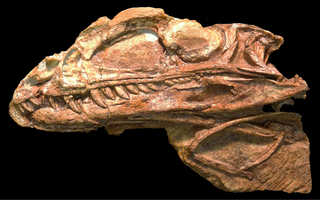
Coelophysis? kayentakatae is an extinct species of neotheropod dinosaur that lived approximately 200–196 million years ago during the early part of the Jurassic Period in what is now the southwestern United States. It was originally named Syntarsus kayentakatae, but the genus Syntarsus was found to be preoccupied by a Colydiine beetle, so it was moved to the genus Megapnosaurus, and then to Coelophysis. A recent reassessment suggests that this species may require a new genus name.
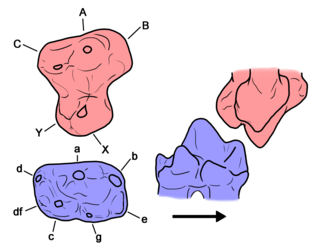
Haldanodon is an extinct docodont mammaliaform which lived in the Upper Jurassic. Its fossil remains have been found in Portugal, in the well-known fossil locality of Guimarota, which is in the Alcobaça Formation. It may have been a semi-aquatic burrowing insectivore, similar in habits to desmans and the platypus. Several specimens are known, include a partial skeleton and well-preserved skulls.

Pseudotherium is an extinct genus of prozostrodontian cynodonts from the Late Triassic of Argentina. It contains one species, P. argentinus, which was first described in 2019 from remains found in the La Peña Member of the Ischigualasto Formation in the Ischigualasto-Villa Unión Basin.
Fossiomanus is an extinct genus of tritylodontid mammaliamorphs from the Early Cretaceous of China. It includes one species, F. sinensis, which is known from a single nearly complete skeleton from the Aptian Jiufotang Formation. Features of its limbs and vertebrae indicate that Fossiomanus was adapted towards a fossorial lifestyle.
